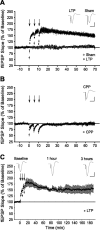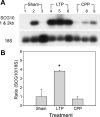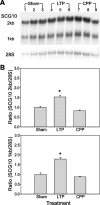Identification of upregulated SCG10 mRNA expression associated with late-phase long-term potentiation in the rat hippocampal Schaffer-CA1 pathway in vivo
- PMID: 12878703
- PMCID: PMC6740634
- DOI: 10.1523/JNEUROSCI.23-16-06617.2003
Identification of upregulated SCG10 mRNA expression associated with late-phase long-term potentiation in the rat hippocampal Schaffer-CA1 pathway in vivo
Abstract
The maintenance of long-term potentiation (LTP) depends on alteration of gene transcription. By screening a subtracted cDNA library that is enriched in upregulated transcripts in rat hippocampus 3 hr after Schaffer-CA1 LTP induction in vivo, we identified a neural growth-associated protein SCG10 (superior cervical ganglia clone 10) gene. The semiquantitative reverse transcription-PCR and Northern blot experiments confirmed that SCG10 mRNA levels were elevated in tetanized rat hippocampi compared with those of sham controls that received only low-frequency stimulation. Both 1 and 2 kb forms of SCG10 mRNAs contributed to the increased expression. Using a riboprobe with a sequence specific to the 3'-untranslated region of rat SCG10 mRNA, in situ hybridization further revealed a significant increase of the SCG10 mRNA 2 kb form in the ipsilateral CA3 and CA1 regions of LTP animals. In addition, we systemically injected the competitive NMDA receptor antagonist d,l-3[(+/-)-2-carboxypiperazine-4-yl]-propyl-1-phosphonic acid (CPP) to determine whether the alteration of SCG10 expression depends on NMDA receptor activation or tetanus alone. Administration of CPP 1 hr before tetanus completely blocked LTP induction and the increase of SCG10 mRNA levels. Thus, these results suggest that the transcription of SCG10 in vivo is regulated by long-lasting synaptic activity and may contribute to the maintenance of long-term synaptic plasticity via a presynaptic remodeling mechanism.
Figures






Similar articles
-
Time-course study of SCG10 mRNA levels associated with LTP induction and maintenance in the rat Schaffer-CA1 pathway in vivo.Brain Res Mol Brain Res. 2004 Jan 5;120(2):182-7. doi: 10.1016/j.molbrainres.2003.10.009. Brain Res Mol Brain Res. 2004. PMID: 14741408
-
N-methyl-D-aspartate receptor-dependent long-term potentiation in CA1 region affects synaptic expression of glutamate receptor subunits and associated proteins in the whole hippocampus.Neuroscience. 2006 Sep 1;141(3):1399-413. doi: 10.1016/j.neuroscience.2006.04.070. Epub 2006 Jun 12. Neuroscience. 2006. PMID: 16766131
-
Developmental shift from long-term depression to long-term potentiation at the mossy fibre synapses in the rat hippocampus.Eur J Neurosci. 1994 Nov 1;6(11):1750-5. doi: 10.1111/j.1460-9568.1994.tb00567.x. Eur J Neurosci. 1994. PMID: 7874314
-
Brain-derived neurotrophic factor triggers transcription-dependent, late phase long-term potentiation in vivo.J Neurosci. 2002 Sep 1;22(17):7453-61. doi: 10.1523/JNEUROSCI.22-17-07453.2002. J Neurosci. 2002. PMID: 12196567 Free PMC article.
-
The selective neuronal NO synthase inhibitor 7-nitro-indazole blocks both long-term potentiation and depotentiation of field EPSPs in rat hippocampal CA1 in vivo.J Neurosci. 1996 Jan;16(1):418-24. doi: 10.1523/JNEUROSCI.16-01-00418.1996. J Neurosci. 1996. PMID: 8613807 Free PMC article.
Cited by
-
The neuronal activity-driven transcriptome.Mol Neurobiol. 2015;51(3):1071-88. doi: 10.1007/s12035-014-8772-z. Epub 2014 Jun 17. Mol Neurobiol. 2015. PMID: 24935719 Review.
-
Taxol and tau overexpression induced calpain-dependent degradation of the microtubule-destabilizing protein SCG10.Exp Neurol. 2006 Nov;202(1):152-60. doi: 10.1016/j.expneurol.2006.05.026. Epub 2006 Jul 5. Exp Neurol. 2006. PMID: 16822511 Free PMC article.
-
Translating the frontiers of brain repair to treatments: starting not to break the rules.Neurobiol Dis. 2010 Feb;37(2):237-42. doi: 10.1016/j.nbd.2009.09.005. Epub 2009 Sep 18. Neurobiol Dis. 2010. PMID: 19770043 Free PMC article. Review.
References
-
- Abraham WC, Dragunow M, Tate WP ( 1991) The role of immediate early genes in the stabilization of long-term potentiation. Mol Neurobiol 5: 297-314. - PubMed
-
- Anderson DJ, Axel R ( 1985) Molecular probes for the development and plasticity of neural crest derivatives. Cell 42: 649-662. - PubMed
-
- Anderson P, Bliss TV, Skrede KK ( 1971) Lamellar organization of hippocampal pathways. Exp Brain Res 13: 222-238. - PubMed
-
- Antonsson B, Lutjens R, Di Paolo G, Kassel D, Allet B, Bernard A, Catsicas S, Grenningloh G ( 1997) Purification, characterization, and in vitro phosphorylation of the neuron-specific membrane-associated protein SCG10. Protein Expr Purif 9: 363-371. - PubMed
Publication types
MeSH terms
Substances
Grants and funding
LinkOut - more resources
Full Text Sources
Miscellaneous
